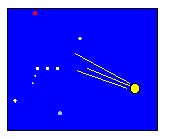 |
Astronomy 101 Problem Set #8 |  |
This Problem Set is due by 1:00 pm on Thursday, 3 November
 |
Astronomy 101 Problem Set #8 |  |
This Problem Set is due by 1:00 pm on Thursday, 3 November
Problem #1: For a second, let's assume that there were canals on Mars running from the poles of the planet to thirsty cities in the equatorial regions. Let's further assume that these canals were very big, with widths of 10 km (that's huge: the Mississippi River is less than 2 km wide along virtually its whole length!).
a) If one were to observe Mars during an opposition (when it is only 0.52 A.U. from Earth), what would the angular width of these 10 km wide canals be?
b) The best Earth-based telescopes can barely distinguish structures with angular sizes of 1 arcsecond (1 arcsecond = 1/3600th of a degree). Would it be possible to see these canals with an Earth-based telescope?
c) How wide would the canals have to be if they could be observed with telescopes from Earth?
Problem #2: The Magellan spacecraft orbited Venus at an altitude of approximately 300 km (above its surface). Assume that the spacecraft's orbit was circular, and calculate its speed in its orbit. (Hint: You'll need to look up the mass and radius of Venus to answer this one.)
Problem #3: Jupiter has an orbital period of 11.9 years.
a) Calculate the semi-major axis of its orbit.
b) Assuming that the orbits of both Jupiter and Earth are circular, calculate the minimum distance between these planets.
c) When Jupiter is as close to us as it ever gets, what is its angular size? (Hint: You'll need to look up Jupiter's radius for this one.)
